Getting The Bug
Except for a small runabout in the early fifties, I have only
owned or built sailboats. The advantages offered by powerboats
for cruising became more attractive as Liz and I sailed past middle
age. For Intracoastal Waterway and inland cruising, the tall mast
and keel of a sailboat restrict access to many areas and the speed
limitation of 6 knots under power can become boring. We have also
experienced the advantages of trailerable boats that can get to
desired cruising grounds at highway speeds, so it was natural
to look at the possibility of a trailerable power cruiser. For
financial reasons and the urge to design my own boat, I decided
to do it myself. Also, none of the available boats on the market
suited my requirements. An association with local naval architect
Graham Byrnes of B&B Yachts in teaching boatbuilding at the
local Community College and building numerous small boats gave
me a valuable introduction to the various aspects of design and
construction, so I felt enabled to begin this project.

Design Objectives
.
The desired speed range gave the most concern. I wanted a cruising
speed of about twice that possible with a sailboat, or 12 to 14mph.
A preliminary study of available powerboats showed that this was
a never-never land for efficient cruising. Planing hulls are prone
to bog down well before getting down to that speed and semi-displacement
hulls only reach it by the application of lots of power. Long,
slender hulls can achieve this speed but are not easily trailerable
unless accommodations are compromised. Much study of Lindsay Lord’s
“Naval Architecture of Planing Hulls” offered hope
that, with careful design and attention to weight control, reliable
planing in a hull of normal aspect ratio (about 3.5 : 1) might
be achieved in this range. Other books by Farmer, Gerr, Edmonds
and Brewer were also useful but Lord’s book is the only
comprehensive study of planing hulls that I was able to locate.
I could not find a copy of Savitsky’s book and some of the
work by him that I saw was highly technical. Note: Since this
article was written, I have found several other sources such as
“High Speed Small Craft” by Peter Du Cane that would
have been helpful but they would not have changed the design in
any significant way.
There are varying opinions on what is acceptable trailering weight,
but our past experience dictated that, for performance, lighter
is better and a limit of 2200 lbs for the boat looked like a reasonable
objective. The weight limitation imposed by both trailering and
performance objectives rule out inboard power, so a four-stroke
outboard seemed the logical choice.

The list of design objectives began to take shape and looked
something like this:
- Small and light enough to be readily trailerable
- Capable of economical cruising at about 12 to 14mph with
a top speed at least 50% higher
- Seaworthy in inshore conditions
- Economical operation
- Sitting headroom in the sleeping cabin and standing headroom
at steering station
- Good, classic appearance
- Reasonably simple to build in plywood and epoxy
These are not listed in order of importance, I wanted them all.
As we shall see, other requirements came along later.
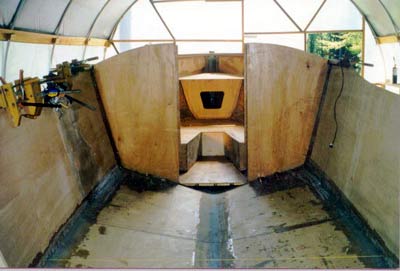
Preliminary Design
In my undoubtedly biased opinion, the classic powerboats of the
early twentieth century are the most aesthetically pleasing. I
had long admired the little 17’ Weston Farmer classic design,
“Sundance”,
with its nearly plumb bow, flush foredeck and broken sheer, so
that became the starting point. In the heyday of custom yacht
building between the world wars, these designs were the undisputed
queens of any fleet. One is occasionally seen today and always
seems to make the surrounding spaceship inspired creations look
like cheap hot tubs by comparison. I hoped to be able to capture
a whiff of the essence of these handsome craft in my boat.
To get adequate sitting headroom in the cabin and have the profile
look right, my eye determined an overall length of at least 22
feet was needed. I had driven one of Sam Devlin’s 22 foot
Surf Scoters at Port Townsend, WA, and it helped to give me some
reference points. Sam’s boats are clearly derived from the
same classic designs that appealed to me. While I found it a very
handsome boat and beautifully built by Sam and his crew, it did
not really fit the concept that I had in mind. It was a heavier,
semi-displacement hull that required a 90hp outboard to give the
speed range I wanted, and it did not have sitting headroom (for
me) over the bunks in the forecabin. Necessary headroom is a subjective
matter, but spending rainy days on a boat without it tends to
bring on “cabin fever” much more quickly.
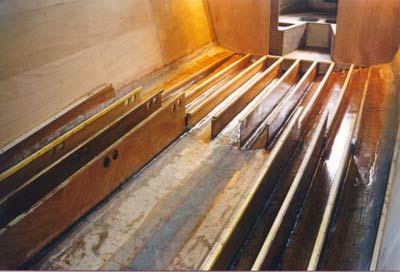
As the requirements and ideas coalesced into a mental picture,
I began to sketch the complete boat. As anyone knows who has ever
followed this path, some ideas prove to be incompatible or unworkable.
It’s a humbling experience as it becomes clear that we are
not quite as knowledgeable as we thought when just daydreaming
or kibitzing someone else’s work. After the initial drawing
was completed, it was time to take a serious look at the waterplane.
I concluded that the monohedron hull, as proposed by Lord, will
best suit my purpose and the next task is to decide on the degree
of deadrise. One school holds that a flat bottom is not only simple
to build but preferred from a performance view. My own experience
is that such boats usually stick their nose in the air while planing
or attempting to plane and pound in any kind of chop. The deep
“V” seems to be the style du’jour, but is not
suitable for this boat. I suspect the conventional wisdom of the
higher wetted surface of the deep-V requiring high power may be
in error. It seems more likely that the high deadrise hull shape
requires a heavy displacement to immerse the chines and make it
acceptably stable and that the resultant high bottom loading is
a major factor in causing the high drag and high power requirements
associated with these hulls.
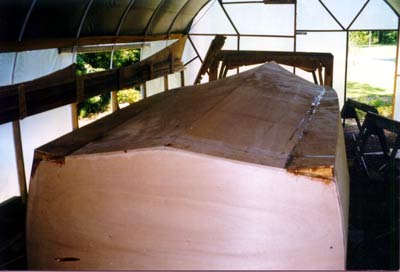
So, what deadrise is needed to satisfy the contradictory requirements
of quick planing, economic operation and rough water capability?
For stability, the aft chine needs to be immersed at the design
displacement and the forward sections need to be fine enough to
not pound excessively but not so fine as to create downwind steering
problems or drop buoyancy and interior room below acceptable levels.
I calculated that 10 degrees for the aft monohedron sections,
forward to near station 6, then rising to 25 degrees at station
2.5 (recommended by Lord along with convex sections near the bow)
as the most reasonable compromise to satisfy the design objectives.
As a point of reference, the C Dory, a popular small power cruiser,
has a deadrise in the aft sections that varies from about 4 degrees
near station 6, to 3 degrees at the transom. This is a very shallow
“V” and, as a result, the C Dory will pound when running
into a chop.
The pronounced knuckle in the bottom bow sections, made necessary
by the nearly plumb bow shape, introduces a great amount of twist
in the bottom panels. I attempted to locate the apex of the conic
sections by the methods described in various texts, but I simply
could not find the beast. Therefore, I resorted to the empirical
method of fitting cardboard to a half model to determine if the
shapes could be formed from flat plywood. Two half models were
carved before I was satisfied that the lines were pleasing to
the eye, developable and also satisfied the hydrodynamic requirements.
The lack of a complete mathematical foundation for the bow shape
was tempered by the experience of visits to the “Hoi toider”
boatbuilders of Harker’s Island and Marshallberg, NC. When
asked how they developed the sometimes-extreme bow shapes for
which they are famous, would reply; “aww, oie just oie ball
it.”

When I showed my half model to one of these old timers, he took
a look at the convex forward sections of the bottom and with a
shake of his head and rolling motions of his hands indicated that
there should be concavity in this part of the hull. We had owned
a small fiberglass shrimp boat with such forward sections and
found it to be bloody awful. Aside from a lack of forward buoyancy,
it had a nasty habit of digging into any off-angle oncoming waves
and trying to throw the occupants overboard. Such concave forward
sections create an exponential buoyancy increase as the bow enters
a wave and result in pounding as the downward motion comes to
a sudden stop. Many of the WW II PT boats with such bows had the
distressing habit of tearing their bottoms out in waves at high
speed. Convex sections allow a much easier entry and should give
a smoother ride to windward. Fortunately, when plywood is bent
and twisted to meet the chine and keel in the forward sections
of a boat, it naturally creates a convex shape.
By this time the design was becoming more fixed and other requirements
and ideas were taking form that changed the direction a bit. It
had proved very difficult to include a suitable galley and head
in the convertible version for extended cruises and a weatherproof
pilothouse began to look a lot more comfortable. I had originally
been attracted to the outboard motor in a partial well in front
of the transom. This is a very common feature of many traditional
workboats here on the Carolina coast and Sam Devlin uses it in
his Surf Scoter designs. It would have been primarily an aesthetic
item although local fishermen use it to allow unobstructed working
of nets over the transom without the risk of tangling fishing
gear in the propeller. In the end I decided that it would rob
some stern buoyancy, adversely affect low speed steering control
and, most of all, take up cockpit room. Anyway, I moved the motor
to the transom and gave the boat two more feet of length to make
the pilothouse more spacious and allow a private stand-up head.
Another plus resulting from mounting the engine on the transom
is that it reduces the transverse width necessary for the engine
space and allows for comfortable permanent seats on each side
of the engine. Changes to the length of the boat were made by
increasing the spacing of the 11 stations which allows the section
shapes and most of the hydrodynamic factors to remain unchanged.
Of course, I was beginning to push my original size and weight
objectives but went ahead anyway.
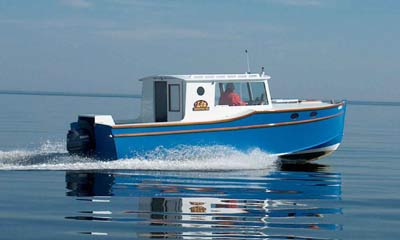
All along the way, I had been using the formulas of Crouch, Keith
and others to make performance projections of speed and power
requirements. It looked like an engine of 50hp might be adequate
to get the cruising and top speeds that I wanted to reach, although
almost all local boaters offered the opinion that it would take
100hp to meet my expectations. They have big, heavy motors on
boats with higher bottom load factors that would be less efficient
than “Liz”, so I went ahead. I also had contact with
owners of Bolger designed 22 foot power cruisers that were supposed
to perform with 50hp but failed to plane and had to be increased
to 90hp or more to reach similar objectives. This was somewhat
disquieting but these boats were heavier (possibly heavier than
Bolger intended) and I’m somewhat skeptical of the effectiveness
of Bolger’s box-keel, flat bottom hull shape, especially
in the transition from displacement to planing mode. Trying to
visualize the flow of water around this hull in the semi-displacement
mode gave me a headache. This is pure intuition since I have no
experience with the type.

The Model
It was time to build a scale model and start some towing tests
to observe the reaction of the hull to varying speed and water
conditions. Several designers report that a model needs to be
at least four feet long in order to give good results. At 24 feet,
“Liz” translates to four feet with a scale ratio of
6:1. The model could also be built with 1/8-inch plywood and still
meet the designed displacement with adequate margin to allow added
lead weights for balance and displacement changes. For simplicity,
the model does not include any structure above the sheerline.
A set of lead weights was cast which allow varying the scale displacement,
from –10% to +80% from nominal, for testing the hull at
varying loads. At a scale of 6:1, the design displacement of 2400lb
translates by the cube of 6 (216) to 11.1lb for the model. A major
departure was made from normal practice in that the aft portion
of the hull bottom was designed so that it could be varied from
a regular monohedron of constant 10 degrees deadrise to a warped
plane, varying from 10 degrees at station 6 to values from 10
degrees down to 0 degrees at the transom in 2 ½ degree
increments. Replaceable sections for the keel and transom set
the warp angle and plastic tape on the chine and keel held everything
together just fine.

All towing setups I’ve seen attach the towline to the bow
but I feel that this can dampen and hide possible instabilities
and so I made a towing bridle that attaches to the approximate
CG of the model. A “Y” yoke of fishline is attached
to the lateral projection of the CG on both sides of the hull.
In practice it proved difficult to get the model started in the
proper direction without running over the yoke, so after some
problems that are explained later, I eventually attached a third
line between the bow and the apex of the “Y.” This
line is normally slack and has no effect unless the model tries
to veer off course. A towing rig was made from a Sunfish boom
that projected to the side of my skiff so that the model could
be run alongside the towboat, in full view, and out of any wake
action. The ability to watch the model up close from the side
allowed observation of any antics in all conditions. The towline
ran through turning blocks to a resistance-measuring device made
from a postal scale. It seems a bit crude but it worked fine,
although the operator had to mentally integrate the bounce of
the scale pointer to arrive at a drag force. Speed was measured
with a digital paddlewheel knotmeter on the towboat. Model speed
varies as the square root of the scale ratio of 6:1, that is,
one knot of model speed equals 2.45 knots in the full size boat..
Time and weather conditions curtailed the test sessions somewhat
and all desired tests were not completed, but I did get useful
information about performance. In its monohedron form, the model
performed well with no visible bad habits and moved smoothly from
slow to max scale speed of about 13.5mph (33mph full scale) in
all sea states. Drag vs. speed data agreed pretty well with predicted
values derived from Lord. It tracked true in scale wave conditions
in which I never intend to run the full sized boat as it would
be an extremely rough ride on both boat and crew. Towing tests
were repeated with the model configured for displacement values
ranging from –10% up to +80% of the nominal design displacement
of 2400 lbs. The model performance exhibited no major changes
other than increased drag as the loading was increased. Due to
design changes outlined earlier, the nominal maximum cruising
displacement has been upped to 2800 lbs. This is still a light
boat, relative to other power cruisers of comparable size. The
model skipped along happily in scale wave conditions that the
full sized boat will never see at the high speeds at which it
was towed.
Adding weight to the model up to a value of 80% over nominal
displacement showed no observable bad habits. The towing drag
increased proportionately to the weight increase throughout the
speed range and the hull made more wake. The added weight was
placed on centerline such that the static trim of the model was
unchanged.
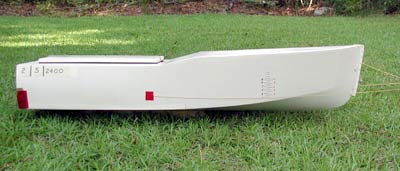
In the second phase of the tests, the model was reconfigured
to a warped hull form. The general consensus is that a warped
hull form will have slightly lower resistance at lower planing
speeds and that the monohedron type is superior at higher speeds.
This may well be true but the difference was not significant enough
to show up on my drag resistance tests. The hull forms appeared
to be about equal in towing resistance at the speeds at which
these tests were run although I did not carry out any tests for
angles of transom deadrise less than 5 degrees. Lindsay Lord reported
that when the warped hull model was towed at higher speeds, it
had a tendency to instability that took the form of rapid sideways
movement or lateral oscillations. It may be very presumptuous
of me to second guess his work, but I think it possible he may
have been misled due to shortcomings in his towing rig. When I
decided to use a bridle attached to the center of gravity of the
hull instead of towing from the bow, I fortuitously made it possible
to view this instability in a different light. Instead of a sideways
movement, my warped hull model exhibited definite yaw instability.
That is, the longitudinal axis of the model oscillated horizontally
about a vertical axis located at or near the Center of Gravity.
At a differential deadrise of 5 degrees between the transom and
amidships, the instability could be first noticed above 10mph
model speed, and became progressively worse up to the maximum
speed at which I was able to tow of a little over 13mph. During
the fastest tow, the oscillations became so great that the model
actually completely swapped ends and destroyed the towing rig.
It was at this point that the third line was added between the
yoke apex and the bow, which would allow the instability to be
seen but would limit the yaw oscillation amplitude below disaster
levels.
Most naval architects say that the twist in the bottom of the
warped hull induces a rotation to the wake on either side due
to the forward motion of the hull. Any rocking of the hull (which
is always present unless the water is glassy smooth) will impart
more or less energy to either side depending on the momentary
immersion of that side. The reaction of the hull to this lateral
imbalance of forces in the after part of the bottom is likely
to include a steering moment imparted to the hull, which sets
the observed yaw oscillation in motion. If this is true then I
understand why nearly all the warped hulls I see, have large skegs
in the afterbody. Such skegs will add considerable lateral resistance
to the stern (like the feathers on an arrow) and tend to damp
out the oscillations before they reach the disastrous level I
observed and make the hull handle acceptably. A bit of further
corroboration is that monohedron “V” hulls are seldom
seen with large skegs. Time, weather conditions and a desire to
get on with building the boat conspired to halt these tests, but
I intend to get back to them later and take a more exhaustive
look at this phenomenon. This reasoning may prove to be incomplete
or even inaccurate, but it seems to best explain the observed
results.

Back To the Boat
The test towing of the monohedron model showed no bad habits
and promised to fulfill the objectives, so I decided to go ahead
with building the boat. One further modification to the bottom
that I had been working on, a chine flat, tapering in width from
zero at the bow to 12 inches at the transom was added at this
time. In addition to the normal spray-deflecting task of such
flats, these are intended to provide additional lift to the stern
sections. The longitudinal trim angle of the flats is one degree
positive relative to the buttocks of the aft monohedron hull sections
and the transverse trim angle is about three degrees negative
for spray suppression. It is my one original contribution to the
hull design of this boat and is intended to optimize its low speed
planing performance and induce longitudinal stability to help
keep the boat level at all speeds. It is designed to work much
like a fixed transom trim tab but without the high drag associated
with trim tabs. If these chines work as planned, they may limit
the top speed, where they may tend to depress the bow, but the
boat is not intended for high speed anyway. Their purpose is to
provide lift to the stern and thereby reduce the high-drag “hump”
in transition from displacement to planing mode and lower the
minimum speed at which the boat will maintain “reliable”
planing. By “reliable”, I mean that the boat must
hold its trim angle and not bog down while maneuvering, encountering
waves and wakes from other boats or changes in crew position.
Ideally, a planing boat would be able to run at any speed from
idle to its maximum, in comfort, under perfect control, with little
change in longitudinal trim angle and without excessive wake at
any speed

The First Run
Liz was launched in early May and the preliminary results are
very encouraging. Top speed with the 50hp Yamaha four-stroke is
23mph and drops to about 19mph with seven adults aboard. Since
this represents far more weight than the design displacement for
cruising with a crew of two, we have no concern as to her performance
loaded to normal limits. There is no discernable planing “hump”
and she runs level at all speeds. When reducing speed, it is difficult
to determine just when planing ceases. She never squats but just
slows down, holding an almost constant trim angle, until finally
settling at about 7 or 8mph. For people used to driving planing
powerboats, this is always a great surprise. Rough water handling
is better than expected. She will run dry and fairly quietly into
a chop at 12mph and by slowing to about 7 or 8mph, quartering
waves in a 20kt southwester were handled with aplomb. We are very
pleased with these results and look forward to some pleasant cruises
in “Liz”.
After Four Seasons
Liz, now as the prototype Bluejacket 24, has satisfied our needs
for a small cruising powerboat over a wide range of conditions.
While most of the miles under the keel have been here on the coastal
sounds of North Carolina, she has been as far from home as the
Trent Severn Waterway and Georgian Bay of Ontario, Canada. The
Yamaha T50 has performed flawlessly and delivered fuel mileage
averaging from 6 ½ to 8 ½ mpg depending on conditions
and speeds. On the high way, the aluminum tandem axle trailer
is very stable and quickly damps out any sway resulting from rapid
steering movements or crosswinds. Several additions such as a
table that fits either in the cockpit or forward cabin, chart
rack, shelves for books and other loose items, towel racks, etc.
make life aboard more pleasant.

I am well pleased with the performance in not so calm water,
which we have in abundance on our sounds. She has made her way
across open water in a northeaster of 35 knots, although I would
not choose to do so again. Steering is very easy and predictable.
The hull bottom design looks like a good compromise between speed
capability and rough water comfort and I can think of nothing
about it I would change. She is very dry in a chop unless run
at an angle to oncoming waves that can blow up the spray on the
windward side.
Launching and retrieving the Bluejacket is so simple that it
lives on the trailer most of the time, which makes maintaining
a clean bottom and other chores much easier. Most of the time
she is covered by a tarp but a boathouse is now well along just
off the driveway.

|

